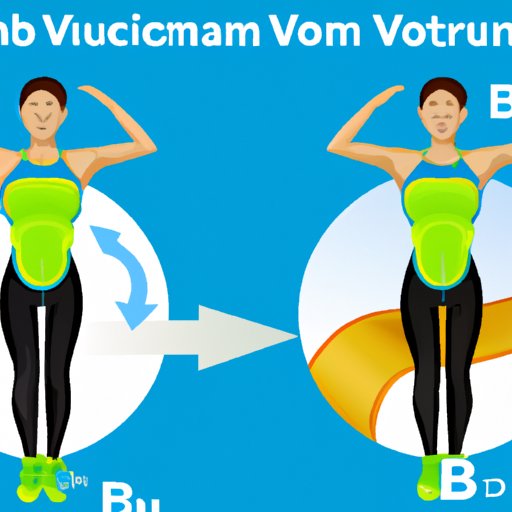Introduction
The stomach vacuum exercise is a great way to help strengthen and tone your core muscles. This exercise is simple yet effective and can be done almost anywhere with minimal equipment. It is also an excellent addition to any workout routine as it helps to improve posture, balance, and stability. In this article, we will explore what the stomach vacuum exercise is, the benefits of doing it, and provide a comprehensive guide on how to do it effectively, as well as some tips and tricks.

Definition of the Stomach Vacuum
The stomach vacuum is a type of core exercise that involves using deep breathing techniques to draw your abdominal muscles inwards towards your spine to create a “vacuum” effect. It is a great way to target the transverse abdominis – the deepest of the abdominal muscles – and is an excellent exercise for those looking to build core strength and stability.

Benefits of the Stomach Vacuum Exercise
The stomach vacuum exercise has many benefits. It helps to strengthen and tone the abdominal muscles, which can improve posture, balance, and stability. It can also help to reduce back pain by strengthening the core muscles which support the spine. Additionally, this exercise can help to increase blood flow to the abdominal region, which can aid in digestion and nutrient absorption. Lastly, it can help to improve overall body awareness and control, making it easier to perform other exercises with proper form.
Comprehensive Guide to the Stomach Vacuum Exercise
How to Perform the Stomach Vacuum Exercise
The stomach vacuum exercise is quite simple to do and requires minimal equipment. To begin, stand with your feet hip-width apart and place your hands on your hips. Begin to take slow, deep breaths and focus on drawing your navel in towards your spine. As you inhale, focus on expanding your abdomen, and as you exhale, focus on drawing your navel in towards your spine as much as possible. Hold this position for 10-15 seconds, or as long as you can, and then release. Repeat this exercise for 3-4 sets of 10-15 reps.
Different Variations of the Stomach Vacuum Exercise
There are several different variations of the stomach vacuum exercise that can be done to target different areas of the abdominal muscles. For example, you can do a standing stomach vacuum by standing upright and focusing on drawing your navel in towards your spine. You can also do a seated stomach vacuum by sitting in a chair with your feet flat on the floor and focusing on drawing your navel in towards your spine. Lastly, you can do a lying stomach vacuum by lying down on your back with your legs bent and feet flat on the ground and focusing on drawing your navel in towards your spine.

Science Behind the Stomach Vacuum Exercise
How Does the Exercise Work?
The stomach vacuum exercise works by targeting the transverse abdominis – the deepest of the abdominal muscles. When this muscle is activated, it helps to compress the abdominal cavity, creating a “vacuum” effect. This helps to strengthen and tone the abdominal muscles, which can improve posture, balance, and stability. Additionally, it can help to reduce back pain by strengthening the core muscles which support the spine.
Benefits to the Body
The stomach vacuum exercise has many benefits for the body. It helps to strengthen and tone the abdominal muscles, which can improve posture, balance, and stability. It can also help to reduce back pain by strengthening the core muscles which support the spine. Additionally, this exercise can help to increase blood flow to the abdominal region, which can aid in digestion and nutrient absorption. Lastly, it can help to improve overall body awareness and control, making it easier to perform other exercises with proper form.
Tips and Tricks for Doing the Stomach Vacuum Exercise Effectively
Preparation
Before performing the stomach vacuum exercise, it is important to warm up your body. This can help to prevent injury and ensure that you get the most out of your workout. A good warm-up should include dynamic stretches such as arm circles, leg swings, and torso twists.
Proper Form
It is important to maintain proper form when performing the stomach vacuum exercise. Make sure to keep your back straight, shoulders back, and chest lifted throughout the exercise. Additionally, make sure to keep your breathing steady and controlled as this will help you to engage your core muscles more effectively.
Breathing Techniques
Breathing is an important part of the stomach vacuum exercise. Focus on taking slow, deep breaths and focus on drawing your navel in towards your spine. As you inhale, focus on expanding your abdomen, and as you exhale, focus on drawing your navel in towards your spine as much as possible. This will help you to engage your core muscles more effectively and get the most out of the exercise.
Conclusion
The stomach vacuum exercise is a great way to help strengthen and tone your core muscles. Not only does it help to improve posture, balance, and stability, but it can also help to reduce back pain and increase blood flow to the abdominal region. To get the most out of this exercise, it is important to maintain proper form, practice breathing techniques, and warm up before each session. With these tips and tricks in mind, the stomach vacuum exercise can be a great addition to any workout routine.


